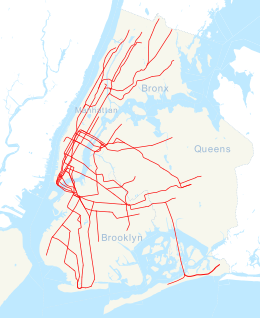79th Street station (IRT Broadway–Seventh Avenue Line)
79th Street is a local station on the IRT Broadway–Seventh Avenue Line of the New York City Subway. Located at the intersection of 79th Street and Broadway on the Upper West Side of Manhattan, it is served by the 1 train at all times and the 2 train during late nights.
79 Street | |||||||||
|---|---|---|---|---|---|---|---|---|---|
Downtown platform | |||||||||
| Station statistics | |||||||||
| Address | West 79th Street & Broadway New York, NY 10024 | ||||||||
| Borough | Manhattan | ||||||||
| Locale | Upper West Side | ||||||||
| Coordinates | 40.784°N 73.98°W | ||||||||
| Division | A (IRT) | ||||||||
| Line | IRT Broadway–Seventh Avenue Line | ||||||||
| Services | 1 2 | ||||||||
| Transit connections | |||||||||
| Structure | Underground | ||||||||
| Platforms | 2 side platforms | ||||||||
| Tracks | 4 | ||||||||
| Other information | |||||||||
| Opened | October 27, 1904[1] | ||||||||
| Station code | 312[2] | ||||||||
| Wireless service | |||||||||
| Opposite-direction transfer available | No | ||||||||
| Traffic | |||||||||
| Passengers (2019) | 4,745,863[4] | ||||||||
| Rank | 96 out of 424[4] | ||||||||
| Station succession | |||||||||
| Next north | 86th Street: 1 | ||||||||
| Next south | 72nd Street: 1 | ||||||||
| |||||||||
| |||||||||
| |||||||||
79th Street Subway Station (IRT) | |||||||||
New York City Landmark No. 1096 | |||||||||
| MPS | New York City Subway System MPS | ||||||||
| NRHP reference No. | 04001018[5] | ||||||||
| NYCL No. | 1096 | ||||||||
| Significant dates | |||||||||
| Added to NRHP | September 17, 2004 | ||||||||
| Designated NYCL | November 24, 1981[6] | ||||||||
History
Operation of the first subway began on October 27, 1904, with the opening of the original 28 stations of the New York City Subway from City Hall to 145th Street on the West Side Branch including the 79th Street station.[7]:162–191[8]
Station layout
| G | Street level | Exit/entrance |
| P Platform level |
Side platform | |
| Northbound local | ← ← | |
| Northbound express | ← | |
| Southbound express | | |
| Southbound local | | |
| Side platform | ||
Like other local stations, 79th Street has four tracks and two side platforms. The two express tracks are used by the 2 train during daytime hours and the 3 train at all times.[9] At this point on the line, the center express tracks are slightly lower than the local tracks, particularly at the north end.
Exits
All fare control areas are on platform level and there are no crossovers or crossunders. The southbound platform is fully staffed, containing a turnstile bank, token booth, staircase going up to the northwest corner of West 79th Street and Broadway, and passageway separated from the platform by a steel fence leading to a staircase that goes up to the southwest corner of the aforementioned intersection. This passageway has a High Entry-Exit Turnstile to the platform and was added after the station's opening as proven by its cinder block tiles.[10]
The northbound platform's fare control is unstaffed, containing a turnstile bank, now-closed customer assistance booth, staircase going up to the southeast corner of West 79th Street and Broadway, and passageway separated from the platform by a steel fence leading to a staircase that goes up to the northeast corner of the aforementioned intersection. This passageway has a High Exit-Only Turnstile to the platform and was also added after the station's opening.[10]
Design and artwork
Both platforms have cream-colored tiles and a pink trim line with "79TH ST" written on it in black sans serif font at regular intervals. These tilings were installed during a 1970s renovation that covered most of the original mosaics and cartouches. Some of these as well as the decorated ceiling beams can still be seen by the fare control areas.
Gallery
 SE corner stairs
SE corner stairs- Name in mosaics
- Original wall decorations and mosaics
 The uptown platform and control area in 1978
The uptown platform and control area in 1978
References
- "Our Subway Open: 150,000 Try It; Mayor McClellan Runs the First Official Train". The New York Times. October 28, 1904. p. 1. ISSN 0362-4331. Retrieved April 21, 2020.
- "Station Developers' Information". Metropolitan Transportation Authority. Retrieved June 13, 2017.
- "NYC Subway Wireless – Active Stations". Transit Wireless Wifi. Retrieved November 13, 2019.
- "Facts and Figures: Annual Subway Ridership 2014–2019". Metropolitan Transportation Authority. 2020. Retrieved May 26, 2020.
- "NPS Focus". National Register of Historic Places. National Park Service. Retrieved November 6, 2011.
- "Interborough Rapid Transit System, Underground Interior" (PDF). New York City Landmarks Preservation Commission. November 24, 1981. Retrieved 2019-11-19.
- Walker, James Blaine (1918). Fifty Years of Rapid Transit — 1864 to 1917. New York, N.Y.: Law Printing. Retrieved November 6, 2016.
- "Subway Opening To-day With Simple Ceremony – Exercises at One O'Clock – Public to be Admitted at Seven – John Hay May Be Present – Expected to Represent the Federal Government – President Roosevelt Sends Letter of Regret" (PDF). The New York Times. October 27, 1904. ISSN 0362-4331. Retrieved May 28, 2017.
- Dougherty, Peter (2006) [2002]. Tracks of the New York City Subway 2006 (3rd ed.). Dougherty. OCLC 49777633 – via Google Books.
- "MTA Neighborhood Maps: Upper West Side" (PDF). mta.info. Metropolitan Transportation Authority. 2015. Retrieved December 30, 2016.
External links
| Wikimedia Commons has media related to 79th Street (IRT Broadway – Seventh Avenue Line). |
- nycsubway.org – IRT West Side Line: 79th Street
- Station Reporter – 1 Train
- Forgotten NY – Original 28 - NYC's First 28 Subway Stations (Part 2)
- 79th Street entrance from Google Maps Street View
- Platforms from Google Maps Street View



%26groups%3D_caf3fc1af50748ef790f726ed37c97fe74e27b7c.svg)

